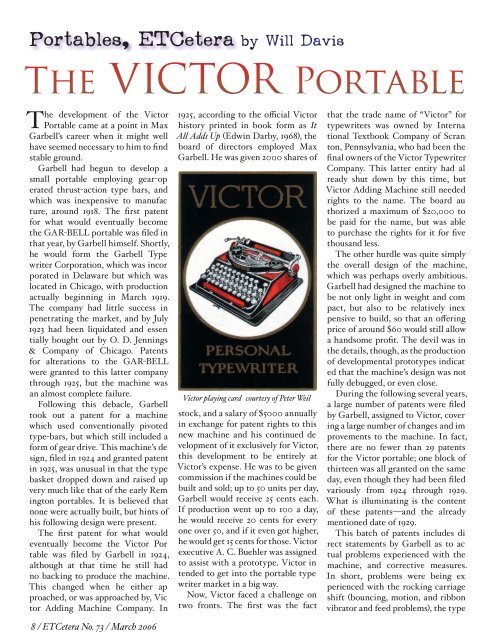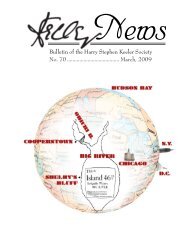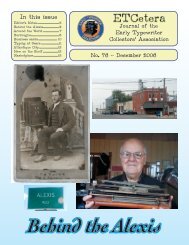John Newton Williams: The Untold Story - Personal Web Sites are ...
John Newton Williams: The Untold Story - Personal Web Sites are ...
John Newton Williams: The Untold Story - Personal Web Sites are ...
Create successful ePaper yourself
Turn your PDF publications into a flip-book with our unique Google optimized e-Paper software.
Portables, ETCetera<br />
<strong>The</strong> development of the Victor<br />
Portable came at a point in Max<br />
Garbell’s c<strong>are</strong>er when it might well<br />
have seemed necessary to him to find<br />
stable ground.<br />
Garbell had begun to develop a<br />
small portable employing gear-op�<br />
erated thrust-action type bars, and<br />
which was inexpensive to manufac�<br />
ture, around 1918. <strong>The</strong> first patent<br />
for what would eventually become<br />
the GAR-BELL portable was filed in<br />
that year, by Garbell himself. Shortly,<br />
he would form the Garbell Type�<br />
writer Corporation, which was incor�<br />
porated in Delaw<strong>are</strong> but which was<br />
located in Chicago, with production<br />
actually beginning in March 1919.<br />
<strong>The</strong> company had little success in<br />
penetrating the market, and by July<br />
1923 had been liquidated and essen�<br />
tially bought out by O. D. Jennings<br />
& Company of Chicago. Patents<br />
for alterations to the GAR-BELL<br />
were granted to this latter company<br />
through 1925, but the machine was<br />
an almost complete failure.<br />
Following this debacle, Garbell<br />
took out a patent for a machine<br />
which used conventionally pivoted<br />
type-bars, but which still included a<br />
form of gear drive. This machine’s de�<br />
sign, filed in 1924 and granted patent<br />
in 1925, was unusual in that the type<br />
basket dropped down and raised up<br />
very much like that of the early Rem�<br />
ington portables. It is believed that<br />
none were actually built, but hints of<br />
his following design were present.<br />
<strong>The</strong> first patent for what would<br />
eventually become the Victor Por�<br />
table was filed by Garbell in 1924,<br />
although at that time he still had<br />
no backing to produce the machine.<br />
This changed when he either ap�<br />
proached, or was approached by, Vic�<br />
tor Adding Machine Company. In<br />
/ ETCetera No. 73 / March 006<br />
by Will Davis<br />
<strong>The</strong> VICTOR Portable<br />
1925, according to the official Victor<br />
history printed in book form as It<br />
All Adds Up (Edwin Darby, 1968), the<br />
board of directors employed Max<br />
Garbell. He was given 2000 sh<strong>are</strong>s of<br />
Victor playing card (courtesy of Peter Weil)<br />
stock, and a salary of $5000 annually<br />
in exchange for patent rights to this<br />
new machine and his continued de�<br />
velopment of it exclusively for Victor,<br />
this development to be entirely at<br />
Victor’s expense. He was to be given<br />
commission if the machines could be<br />
built and sold; up to 50 units per day,<br />
Garbell would receive 25 cents each.<br />
If production went up to 100 a day,<br />
he would receive 20 cents for every<br />
one over 50, and if it even got higher,<br />
he would get 15 cents for those. Victor<br />
executive A. C. Buehler was assigned<br />
to assist with a prototype. Victor in�<br />
tended to get into the portable type�<br />
writer market in a big way.<br />
Now, Victor faced a challenge on<br />
two fronts. <strong>The</strong> first was the fact<br />
that the trade name of “Victor” for<br />
typewriters was owned by Interna�<br />
tional Textbook Company of Scran�<br />
ton, Pennsylvania, who had been the<br />
final owners of the Victor Typewriter<br />
Company. This latter entity had al�<br />
ready shut down by this time, but<br />
Victor Adding Machine still needed<br />
rights to the name. <strong>The</strong> board au�<br />
thorized a maximum of $20,000 to<br />
be paid for the name, but was able<br />
to purchase the rights for it for five<br />
thousand less.<br />
<strong>The</strong> other hurdle was quite simply<br />
the overall design of the machine,<br />
which was perhaps overly ambitious.<br />
Garbell had designed the machine to<br />
be not only light in weight and com�<br />
pact, but also to be relatively inex�<br />
pensive to build, so that an offering<br />
price of around $60 would still allow<br />
a handsome profit. <strong>The</strong> devil was in<br />
the details, though, as the production<br />
of developmental prototypes indicat�<br />
ed that the machine’s design was not<br />
fully debugged, or even close.<br />
During the following several years,<br />
a large number of patents were filed<br />
by Garbell, assigned to Victor, cover�<br />
ing a large number of changes and im�<br />
provements to the machine. In fact,<br />
there <strong>are</strong> no fewer than 29 patents<br />
for the Victor portable; one block of<br />
thirteen was all granted on the same<br />
day, even though they had been filed<br />
variously from 1924 through 1929.<br />
What is illuminating is the content<br />
of these patents—and the already<br />
mentioned date of 1929.<br />
This batch of patents includes di�<br />
rect statements by Garbell as to ac�<br />
tual problems experienced with the<br />
machine, and corrective measures.<br />
In short, problems were being ex�<br />
perienced with the rocking carriage<br />
shift (bouncing, motion, and ribbon<br />
vibrator and feed problems), the type





